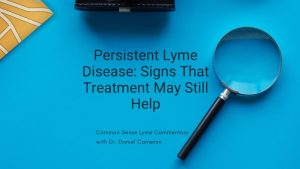Call for your appointment today 914-666-4665 | Mt. Kisco, New York

There is growing evidence supporting the existence and severity of chronic manifestations of Lyme disease despite recent treatment guidelines for Lyme disease. Studies have found that at least 1 in 3 patients treated for Lyme disease remained ill years after treatment. Furthermore, 4 clinical trials sponsored by the National Institutes of Medicine (NIH) documented the existence and severity of chronic manifestations of Lyme disease.[2-6]
Treating Lyme disease, whether it’s in the chronic or early stages of illness, can be complex and challenging. Many of the Lyme disease patients in the NIH trials remained ill for years, despite treatment. In fact, researchers reported that chronic Lyme disease patients’ quality of life “was equivalent to that of patients with congestive heart failure; pain levels were similar to those of post-surgical patients and fatigue was on par with that seen in multiple sclerosis,” according to the International Lyme and Associated Diseases Society’s (ILADS) 2014 evidence-based guidelines.
Meanwhile, studies from Johns Hopkins indicated that patients diagnosed with “post-treatment Lyme disease syndrome (PTLDS)” continued to be ill following antibiotic treatment, even though they received antibiotic therapy early on. PTLDS patients in the study suffered severe fatigue, pain, cognitive complaints, and poor function.
“Studies using rodent and primate models have suggested that the persistence of bacteria and/or spirochetal antigens after antibiotic therapy may drive disease,” explains Aucott from Johns Hopkins University School of Medicine.
[bctt tweet=”IDSA’s proposed Lyme disease guidelines dismiss psychiatric, behavioral and neurodevelopmental manifestations due to Lyme disease. ” username=”DrDanielCameron”]
The IDSA guideline committee is again at-bat. This time, the committee included representatives from a broad range of other organizations in developing the guidelines. Their proposed Lyme disease guidelines have accepted the existence and severity of just one chronic manifestation of Lyme disease. That being, post-treatment Lyme arthritis.
“In patients who have failed one course of oral antibiotics and one course of IV antibiotics, we suggest a referral to a rheumatologist or other trained specialist for consideration of the use of disease-modifying anti-rheumatic drugs (DMARDs), biologic agents, intra-articular steroids, or arthroscopic synovectomy,” states the latest IDSA guidelines draft from August 2019.
Proving causality: Lyme disease and chronic manifestations
Unfortunately, the proposed guidelines do not accept the existence and severity of other chronic manifestations of Lyme disease, particularly those involving psychiatric, behavioral or neurodevelopmental manifestations. The committee dismissed these chronic manifestations of Lyme disease as not causal. As the authors state:
- “No studies suggest a convincing causal association between Lyme disease and any specific psychiatric conditions.”
- “There are no data to support a causal relationship between tick-borne infections and childhood developmental delay or behavioral disorders (such as attention deficit hyperactivity disorder, autistic spectrum disorders, Pediatric Autoimmune Neuropsychiatric Disorders Associated with Streptococcal Infections (PANDAS), learning disabilities, or psychiatric disorders).”
The treatment guidelines for Lyme disease committee’s argument is arguably similar to the debate on whether smoking causes lung cancer. “At that time, the results of epidemiological studies had shown associations of smoking with increased risk for lung cancer and other cancers, for coronary heart disease, and for ‘emphysema’ and ‘bronchitis,’” writes Glass from Johns Hopkins University in the Annual Review of Public Health. [15]
The tobacco industry questioned the evidence. “Even as the epidemiological evidence mounted, the tobacco industry implemented a wide-ranging strategy to question the credibility of epidemiological evidence generally and of the most pivotal studies specifically,” writes Glass.
They created and spread doubt, as Glass explains, “The manufacture and dissemination of doubt remain strategies today, widely used by stakeholders whose interests are potentially threatened by a causal finding.”
The Infectious Diseases Society of America treatment guidelines for Lyme disease appears to be using the causality argument to question the evidence and manufacture and disseminate doubt.
If this draft is finalized, the committee is arguably about to strike out again for both doctors in clinical practice and their patients.
Editor’s note: Dr. Cameron is the first author for the 2004 and 2014 International Lyme and Associated Diseases Society (ILADS) treatment guidelines for Lyme disease that accepted the existence and severity of chronic Lyme disease.
It has become clearer that patients initially identified as having chronic Lyme disease suffer from a broad range of presentations including:
- Lyme encephalopathy [8]
- Lyme neuropathy [8]
- Neuropsychiatric Lyme disease [9]
- Pediatric neuropsychiatric disorders – PANS [10]
- Lyme carditis [11]
- Autonomic dysfunction – POTS [12]
- Post-treatment Lyme fatigue – Post-Lyme disease [6]
- Neuropathic pain [13]
- Persistent symptoms after Lyme disease [5]
- Lyme disease with co-infections (e.g. Babesia) [14]
Related Articles:
Dismissing chronic Lyme disease for somatic symptom disorder
New study by guidelines author dismisses risk of chronic Lyme disease
References:
- Wormser GP, Dattwyler RJ, Shapiro ED, et al. The clinical assessment, treatment, and prevention of lyme disease, human granulocytic anaplasmosis, and babesiosis: clinical practice guidelines by the Infectious Diseases Society of America. Clin Infect Dis. 2006;43(9):1089-1134.
- Asch ES, Bujak DI, Weiss M, Peterson MG, Weinstein A. Lyme disease: an infectious and postinfectious syndrome. J Rheumatol, 21(3), 454-461 (1994).
- Shadick NA, Phillips CB, Logigian EL et al. The long-term clinical outcomes of Lyme disease. A population-based retrospective cohort study. Ann Intern Med, 121(8), 560-567 (1994).
- Fallon BA, Keilp JG, Corbera KM et al. A randomized, placebo-controlled trial of repeated IV antibiotic therapy for Lyme encephalopathy. Neurology, 70(13), 992-1003 (2008).
- Klempner MS, Hu LT, Evans J et al. Two controlled trials of antibiotic treatment in patients with persistent symptoms and a history of Lyme disease. N Engl J Med, 345(2), 85-92 (2001).
- Krupp LB, Hyman LG, Grimson R, et al. Study and treatment of post Lyme disease (STOP-LD): a randomized double masked clinical trial. Neurology. 2003;60(12):1923-1930.
- Rebman AW, Bechtold KT, Yang T, et al. The Clinical, Symptom, and Quality-of-Life Characterization of a Well-Defined Group of Patients with Posttreatment Lyme Disease Syndrome. Front Med (Lausanne). 2017;4:224.
- Logigian EL, Kaplan RF, Steere AC. Chronic neurologic manifestations of Lyme disease. N Engl J Med. 1990;323(21):1438-1444.
- Fallon BA, Nields JA. Lyme disease: a neuropsychiatric illness. Am J Psychiatry. 1994;151(11):1571-1583.
- Sigra S, Hesselmark E, Bejerot S. Treatment of PANDAS and PANS: a systematic review. Neurosci Biobehav Rev. 2018;86:51-65.
- Muehlenbachs A, Bollweg BC, Schulz TJ, et al. Cardiac Tropism of Borrelia burgdorferi: An Autopsy Study of Sudden Cardiac Death Associated with Lyme Carditis. Am J Pathol. 2016.
- Kanjwal K, Karabin B, Kanjwal Y, Grubb BP. Postural orthostatic tachycardia syndrome following Lyme disease. Cardiology journal. 2011;18(1):63-66.
- Simons LE. Fear of pain in children and adolescents with neuropathic pain and complex regional pain syndrome. Pain. 2016;157 Suppl 1:S90-97.
- Krause PJ, Telford SR, 3rd, Spielman A, et al. Concurrent Lyme disease and babesiosis. Evidence for increased severity and duration of illness. Jama. 1996;275(21):1657-1660.
- Thomas A. Glass, Steven N. Goodman, Miguel A. Hernán, and Jonathan M. Samet. Causal Inference in Public Health. Annu Rev Public Health. 2013; 34: 61–75.




This makes it more important that a national program of education in schools and communities be implemented by the Departments of Health and Departments of Education be developed and implemented at all levels on a constant curriculum schedule. Tick bite prevention is a constant risk for all the population. The intensity and frequency of education requirements can be apportioned according to patient population geographic concentration. In this case an ounce of prevention is worth a ton of cure. It was true for HIV. Its true for Lyme Disease.